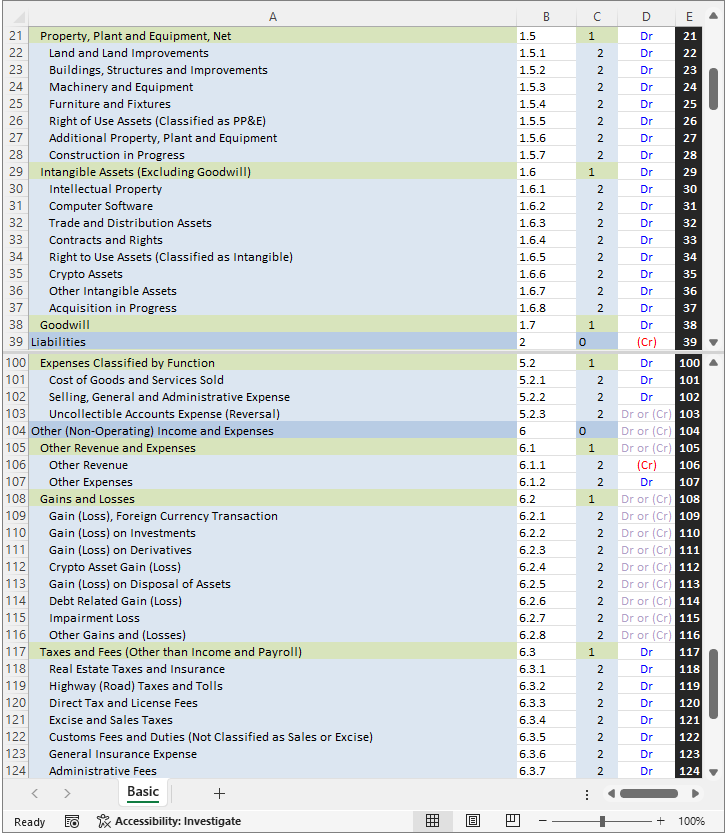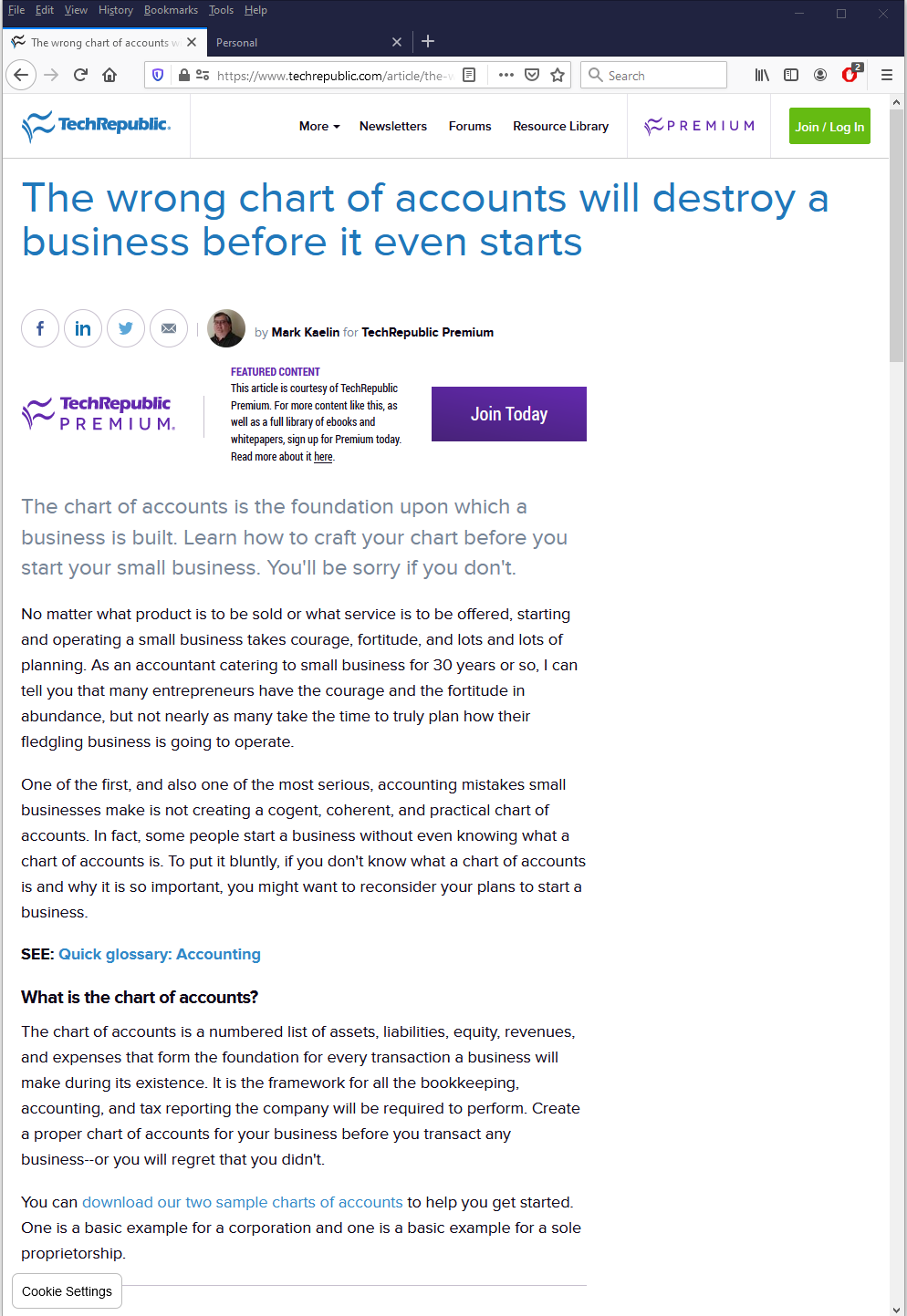This page includes a chart of accounts that can be used with most accounting standards as well as COAs tailored to IFRS and US GAAP. Each COA is available in various versions, from basic to expert.
The accounting standards of countries such as the UK, Canada, or Australia do not prescribe a particular chart of accounts, so they can be considered comparable to IFRS and US GAAP.
In contrast, the accounting legislation in most EU countries, as well as in countries like Russia, Brazil, or Nigeria, does prescribe a mandatory chart of accounts. If they also allow or require entities to report under IFRS standards, they may or may not allow an IFRS-compatible COA to be used instead of the mandatory national COA.
While the universal COA available on this site can be used in various jurisdictions, this site does not maintain a list of countries where this would be allowed. Its users are thus advised to always make sure they are following the appropriate national accounting requirements.
Legal entities domiciled in some countries are not permitted to deviate from the COAs prescribed by national law and, in some these countries, doing so is a criminally punishable act.
Consequently, the COAs downloadable from this site cannot used in conjunction with national GAAP standards unless this procedure is permitted by those standards or national law.
For example, in the European Union, there are two layers of accounting standards. One (IFRS) is required by Regulation: EU 1606/2002 (link: ec.europa.eu) and the other (national GAAP) is governed by Directive 2013/34/EU (link: eur-lex.europa.eu).
While IFRS is created by the IASB (a non-profit, international organization, link: eifrs.ifrs.org) and so is not law, national GAAP is created by member state legislatures and so is law.
The difference is that while IFRS is judgmental, national GAAP is legalistic. While IFRS focuses on disclosure and reporting, national GAAP concentrates on accounting procedure. While IFRS does not prescribe (or even discuss) a chart of accounts, national GAAP prescribes one, making unauthorized deviations from this COA punishable by law.
Nevertheless, as EU 1606/2002 requires IFRS for public companies (at the consolidated entity level), national law must accommodate this regulation. This implies that EU member states may allow legal entities to use IFRS in place of national GAAP in certain situations.
For example, in the Czech Republic, the Accounting Act 563/1991 paragraph §19a (1) states:
"An [unconsolidated] entity that is a trading company and is an issuer of investment securities admitted to trading on a European regulated market shall apply international accounting standards regulated by European Union law (hereinafter referred to as "international accounting standards") for accounting and the preparation of financial statements" [paragraph § 23a requires IFRS at the consolidated entity level].
This implies that, since the COA downloadable from this site may be used for IFRS purposes and IFRS shall be applied for accounting purposes, using the COA downloadable from this site in place of the prescribed CZ GAAP COA is (implicitly) allowed, but only for a trading company (consolidated entity) that is an issuer of investment securities admitted to trading on a European regulated market.
For example, in the Czech Republic it would be possible to use the COA downloadable from this site in place of the COA prescribed by CZ GAAP in the those situations, even if CZ GAAP cannot be ignored altogether.
Although it is an IFRS/US GAAP advisory firm, the owner of this web site is a legal entity domiciled in the Czech Republic. As a result, it must use CZ GAAP for statutory accounting purposes.
While we do not have similar, in-depth experience with other member state accounting laws, since the Czech Republic is subject to the same EU directives and regulations as all other member states, its accounting legislation is generally comparable.
For example, Czech national standards (link: businesscenter) say this about recognizing revenue (CAS 19. 4.2): "the sale of products and merchandise is, on the basis of relevant documents (such as invoices), credited to the relevant account in account group 60 - Revenue with the corresponding debit made to the relevant account in account group 31 - Receivables (short and long-term) or account group 21 - Cash."
Similarly, French (link: anc.gouv.fr) accounting standard Art. 947-70 (view pdf) states: "… Les montants des ventes, des prestations de services, des produits afférents aux activités annexes sont enregistrés au crédit des comptes 701 "Ventes de produits finis", 702 "Ventes de produits intermédiaires", 703 "Ventes de produits résiduels", 704 "Travaux", 705 "Études", 706 "Prestations de services", 707 "Ventes de marchandises" et 708 "Produits des activités annexes"."
While both standards are clear on the accounts that must be used, they make no mention of the conditions to be met before these accounts are used.
In contrast, IFRS 15.31 | ASC 606-10-25-23 state: ...An entity shall recognize revenue when (or as) the entity satisfies a performance obligation by transferring a promised good or service (i.e. an asset) to a customer. An asset is transferred when (or as) the customer obtains control of that asset....
While IFRS and US GAAP, are clear the condition (transfer of control) for recognizing revenue, they make no mention of the accounts to be used.
Please note: even though we have a world-wide subscriber/client base, we to not claim to be experts in any national GAAP, nor can we advise any entity on how these rules and regulations can or should be applied.
The Income Tax Act 586/1992 §23 (2) states:
"The tax base is determined a) from the net income (profit or loss), always without the influence of International Accounting Standards, for taxpayers required to maintain accounts. A taxpayer that prepares financial statements in accordance with International Accounting Standards regulated by European Community shall apply for the purposes of this Act to determine net income and to determine other data decisive for determining the tax base a special legal regulation [CZ GAAP]). When determining the tax base, entries in off-balance sheet account books are not taken into account, unless otherwise provided in this Act. ..."
This implies that even in those situations where a different standard or COA is used for accounting purposes, the result must be adjusted so that net income equals what it would have been if CZ GAAP had been applied throughout the period.
Since these adjustments can be onerous, it is not an approach we recommend to our clients.
A change in law, that would allow IFRS to be used to determine taxable income (thus eliminating this CZ GAAP adjustment) is under consideration.
If this change is implemented, our recommendation will also, depending on how that law is implemented, likely change.
Instead, the approach we recommend is to separate IFRS | US GAAP and national GAAP accounting.
The optimal way to achieve this separation has proved to be:
1. Establish an in-house reporting system designed around the recognition, measurement and reporting requirements of the primary standard (generally the standard the consolidated entity reports in its primary market). For a US listed company, that would be US GAAP. For a EU listed company, that would be IFRS. For a US listed foreign private issuer it could be either.
2. Establish an in-house policy for the adjustments between IFRS and US GAAP (or vice versa).
3. Outsource national GAAP to a licensed national accountant / insured tax advisor.
This recommendation also applies to companies whose reporting obligation does not arise from a stock market listening. For example, we have several clients with subsidiaries located in the United States that are required to use accrual accounting (US GAAP) for US taxation purposes.
Since these companies generally use either IFRS or local GAAP as their primary reporting/accounting system, they tend to outsource their US accounting and tax to US based CPA's, primarily because maintaining a dedicated, in-house team of accountants for this purpose is not a cost effective solution.
The advantage of this approach is that it tends to be cost effective and, provided the service provider is licensed and adequately insured, eliminates (or at lease significantly mitigates) the risks associated with national accounting/tax compliance.
Obviously these recommendations apply primarily to smaller companies rather than multinational enterprises with the budget to maintain separate, in-house teams dedicated to each standard and/or jurisdiction.
Consequently, before applying the CAO available for download from this site for national GAAP purposes, we strongly recommend consulting an accounting and/or legal professional qualified to interpret national legislation.
An additional discussion of what constitutes a comparable standard is provided in the release notes.
Neither IFRS (link: eifrs.ifrs.org) nor US GAAP (link: asc.fasb.org) defines a chart of accounts.
To fill this void, this site has been publishing COAs since 2010.
This is not the only site to publish a COA.
A Google search quickly yields some relatively workable examples, some less useful results but more often sites that would rather talk about it than do it.
Strategic CFO (link: strategiccfo.com) publishes one of the better examples.
While it is better than some examples, it still is not particularly good. Its account numbering is not easily expandable. Inventory has missing material. Accumulated depreciation/amortization is presented as separate account class, which makes the COA cumbersome (each unit of account appears in two places). Organization costs are not an asset (at least not under IFRS or US GAAP). Rent is rarely accrued. Subclassifying Cost of Goods Sold by product is useful from a managerial perspective, but in practice it will lead to hundreds of duplicate sub-accounts or the need to reclassify expenses items like direct material or direct wages leading to messy accounting. Also, not including depreciation expense in COGS (it is all listed in operating expenses) ignores basic, full absorption costing principles. The list of items classified as operating expenses seems fairly arbitrary.
We could go on, but since the site does not charge for its COA, you get what you pay for.
This site, while it correctly points out: The wrong chart of accounts will destroy a business before it even starts publishes one that is so poor, it may just do exactly what they warn against.
In my opinion (who am I), this COA is so bad that charging money for it is an insult.
Not only is it so rudimentary as to be practically useless and structured in a way to make it practically unscalable, it was created by someone who does not actually know what an account is.
How else can one explain that "599 Total Income, 698 Total Cost of Goods Sold, or 699 Total Gross Margin" are listed as accounts when, in fact, they are financial report sub-totals.
While this piece of work cannot be republished here in its entirety, I can shown an edited sample so hopefully the visitors to our site will not waste $49.90 downloading it from Techrepublic.
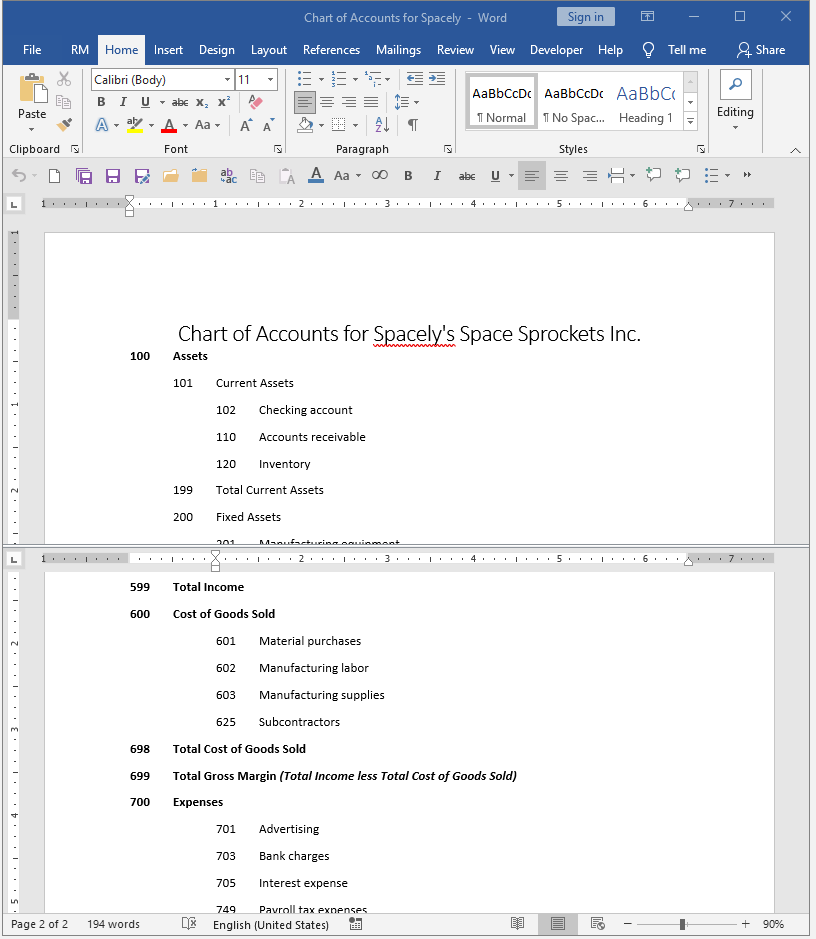
This site (link: toptal.com) discusses the importance of a good COA at great length.
It does not, however, get around to publishing one.
Why? Probably because talking is easier than doing.
For example, when we design a custom COA for a company, if the company is small and simple (one division, not listed on any exchange), it can take days to make sure the COA fulfills both the company's tax reporting obligations and management's informational needs.
And no, management cannot simply ignore tax reporting like the site we are criticizing suggests.
Sure, it is true that "tax and audit CPAs have the custom reporting software to easily convert your management-oriented chart of accounts into their format. Just be sure to make it easy for them by incorporating any special accounts they need into your remodeled chart accounts."
The problem is the "Just be sure to make it easy for them by incorporating any special accounts they need into your remodeled chart accounts." is the hard part and, unless done very well, often leads to a tax CPA's services being more costly than they would otherwise have been.
We suppose this may also be the reason why this tax CPA makes this suggestion.
Then again, maybe we are just being cynical.
Once the company becomes more complicated (multiple divisions, multiple tax jurisdictions), it can take weeks.
Once the company becomes complicated (listed on an exchange with an IFRS and/or US GAAP reporting obligation), it can take months.
Even the standard COAs downloadable here were not easy.
For example, the universal COA (and all of its versions) took almost a year and over 1400 man hours.
Then again, no ever said creating a COA for usable with two different reporting standards and two (generally incompatible) XBRL taxonomies was going to be a stroll in the park.
In the end, management can decide what works best for them and their company.
In general, two approaches are possible:
A. base the COA on financial accounting.
B. base the COA on managerial accounting.
Approach A requires that an accounting standard first be selected.
In general, the possibilities include: US GAAP, IFRS, tax accounting rules or a national GAAP.
In this respect, the management of a company operating in a country that prescribes a national GAAP has it easy.
Instead of having to decide which standard will work best, they either apply the national GAAP or go to prison.
A more detailed discussion of national GAAP is available in the release notes.
Once that standard has been selected, the COA is designed around that standard's recognition guidance. The more closely it adheres to that guidance, the less likely mistakes in applying that guidance will be made.
Approach B does not require an accounting standard be selected at all. Instead, management designs the COA around its own needs using managerial accounting principles.
The advantage of approach A is that it makes creating the financial report relatively straight forward. This is especially important for a company that must submit that report to a regulator like the US SEC.
A common account structure is also important for a company with operating in multiple jurisdictions. Without a common COA, consolidating these divisions is daunting (if possible at all).
The advantage of approach B is that it makes the job of managing a company easier.
For example, there is no requirement in any accounting standard that companies break sales down, for example, by product type, store location, in-store location, shelf-space height, proximity to other merchandise or any of a myriad of data points useful to management in evaluating how a particular merchandise item contributes to the company's bottom line.
In the United States, the question of which approach is better rarely comes up.
One reason, most companies in the US have no divisions in other countries. Some Americans even have trouble finding a country like the Czech Republic on a map.
Another reason, unless they cross the IRS's threshold for accrual accounting, preparing a tax return is pretty much: receipts - disbursements = taxable income (even if some tax CPAs make it out to be some kind of dark art).
Obviously, an accountant working at such a company can stop reading (assuming he or she has gotten this far) and visit some other site.
This site is not meant to address the needs of these companies.
Instead, it is designed to address the needs of companies that must, for whatever reason, apply US GAAP or IFRS guidance in full.
However, this freedom dissipates when a company registers with the SEC (US GAAP) or EU member state regulator (IFRS).
The reason is simple.
If the company does not apply one or the other standard correctly, its management is criminally liable.
In the United States, Sarbanes–Oxley establishes management’s reporting obligations.
Link: govinfo.gov:
`Sec. 1350. Failure of corporate officers to certify financial reports
(a) CERTIFICATION OF PERIODIC FINANCIAL REPORTS- Each periodic report containing financial statements filed by an issuer with the Securities Exchange Commission pursuant to section 13(a) or 15(d) of the Securities Exchange Act of 1934 (15 U.S.C. 78m(a) or 78o(d)) shall be accompanied by a written statement by the chief executive officer and chief financial officer (or equivalent thereof) of the issuer.
`(b) CONTENT- The statement required under subsection (a) shall certify that the periodic report containing the financial statements fully complies with the requirements of section 13(a) or 15(d) of the Securities Exchange Act pf 1934 (15 U.S.C. 78m or 78o(d)) and that information contained in the periodic report fairly presents, in all material respects, the financial condition and results of operations of the issuer.
`(c) CRIMINAL PENALTIES- Whoever--
`(1) certifies any statement as set forth in subsections (a) and (b) of this section knowing that the periodic report accompanying the statement does not comport with all the requirements set forth in this section shall be fined not more than $1,000,000 or imprisoned not more than 10 years, or both; or
`(2) willfully certifies any statement as set forth in subsections (a) and (b) of this section knowing that the periodic report accompanying the statement does not comport with all the requirements set forth in this section shall be fined not more than $5,000,000, or imprisoned not more than 20 years, or both.'.
department or agency of the United States or any case filed under title 11, or in relation to or contemplation of any such matter or case, shall be fined under this title, imprisoned not more than 20 years, or both.While few countries have legislation quite as strict, violating securities law is a serious offence practically everywhere.
This site publishes COAs for these kinds of companies.
The COAs available for download here are specifically designed to be compatible with US GAAP and/or IFRS.
Obviously, since managerial accounting is important to management, the COAs are also designed to be expandable.
However, as every company is different, it is not possible for a standardized COA to meet every managements’ needs.
Instead, it requires a bespoke COA, tailored specifically to fit each specific company.
To help small companies just starting out, the COA on this page is free of charge.
Even though it is free, it is perfectly workable.
More importantly, it can be scaled to grow with the business as it moves from startup to IPO.
Small, private companies do not need much of a COA. Something like this (Link: quickbooks.intuit.com) will do.
But if a company wants to grow, it will need something more robust, especially if it intends to eventually list on an stock exchange or sell itself to a listed corporation.
For this reason, the COAs published on this site are designed to be scaled in a way that would suit even a multinational company with hundreds of divisions.
Obviously, as a company grows, we would be glad if it subscribed to this site or used some of our services.
But even if it never does, we are still happy to help anyone brave enough to start a business by providing a workable COA free of charge.
Downloads of the advanced COAs, suitable for larger companies, are available to subscribers.
The cost to subscribe is €89.90 per year.
Subscription is for one year only and does not renew automatically.
To subscribe, please visit the subscription page.
If you have already subscribed, please log in.
Why is a subscription necessary?
Maintaining a web site and creating its content involves a cost.
Like many sites, we could sell selling advertising to cover this cost.
However, we would rather not treat our visitors as merchandise to be sold advertisers.
Instead, we rely those visitors who find our content useful enough to support this site by subscribing.
Professional view allows downloads all the COAs in Excel format.
Professional view costs €89.90 for one year.
Professional view does not renew automatically.
Get professional view or log in.
Update: April 2025
The 2025 version has been revised and updated to improve operability.
The XBRL cross-reference sheet has been updated to reflect the 2025 FASB-issued taxonomy. Once the IASB publishes its 2025 taxonomy, it will be updated to reflect any changes.
For reference, the 2024 pro versions will remain available for download during a transition period.
Universal COA (html)
While generally comparable, IFRS and US GAAP do not provide identical guidance.
For example, while IFRS allows low value assets to be treated as rentals, US GAAP requires all right of use assets, where the lease term exceeds 1 year, to be capitalized regardless of value. Or, while IFRS requires long-term provisions to be discounted, US GAAP does not have the same requirement for contingencies. Or, while IFRS allows development to be capitalized, US GAAP does not. And so on.
Thus, if the universal COA is used for dual reporting purposes, adjustments will need to be made. The same applies if it is used by a parent that consolidates subsidiaries using the two standards. For this reason, our Illustrations section outlines the most common differences between IFRS and US GAAP.
We strongly suggest reviewing the Illustrations thoroughly before attempting to use the universal COA for dual reporting or consolidation purposes.
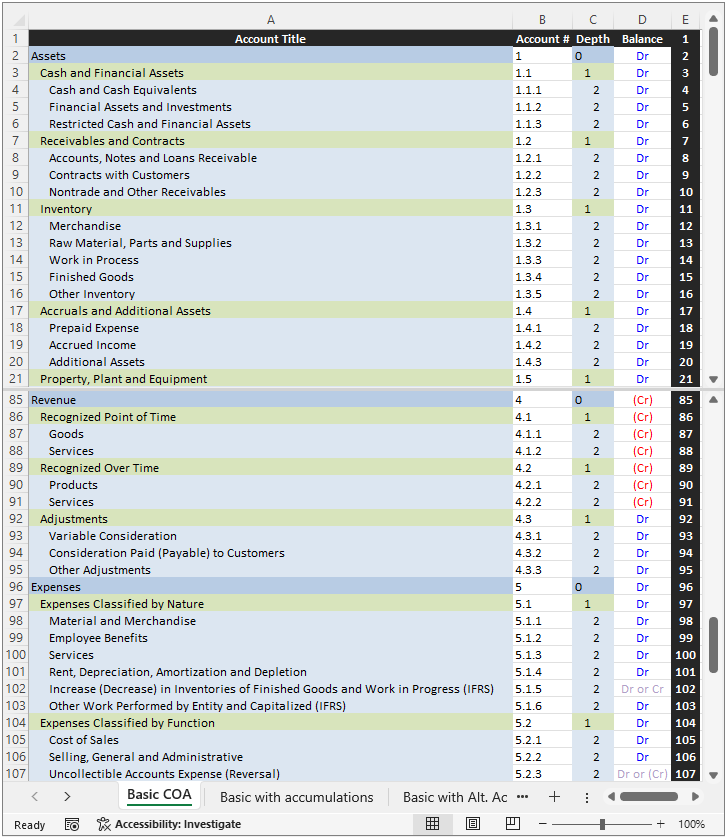
IFRS COA (html)
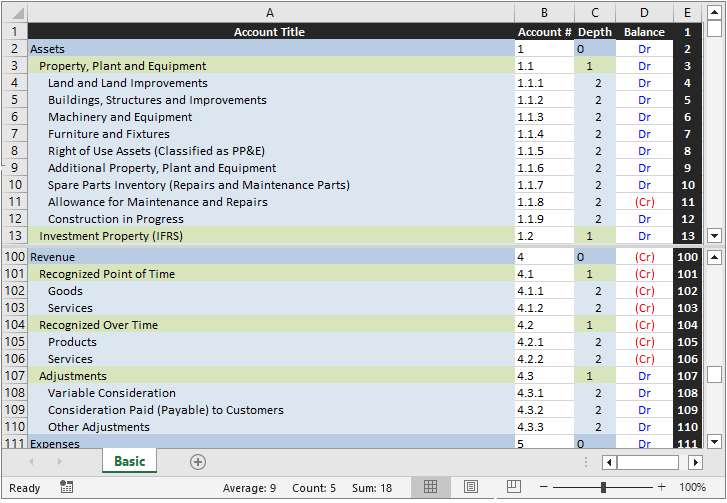
US GAAP COA (html)
